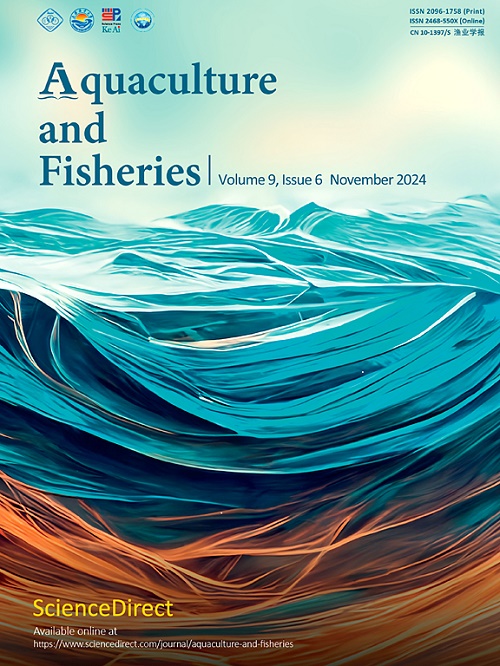Different types of dietary carotenoids improve the color and odor quality of Eriocheir sinensis ovaries
Q1 Agricultural and Biological Sciences
引用次数: 0
Abstract
Chinese mitten crab, Eriocheir sinensis, is a commercially ecological crab species in China. Ovaries are one of the major edible parts for female E. sinensis, and their color and flavor primarily affect consumer acceptance. This study investigated the effects of different dietary carotenoids on the color and odor quality of adult female E. sinensis ovaries. The crab was fed the experiment diets with supplementation of 100 ×10−6 of β-carotene, astaxanthin, lutein, canthaxanthin and zeaxanthin, respectively, for 70 days, while the control diet without the supplementation of carotenoids. The results showed that different carotenoids generated an orange-red coloration on crab ovaries, and astaxanthin and canthaxanthin significantly increased the redness (P < 0.05). All carotenoid groups had higher total carotenoids and fatty acid contents than the control group. Moreover, β-carotene significantly promoted ovarian carotenoid deposition, and lutein predominantly affected fatty acid accumulation (P < 0.05). β-carotene and lutein groups accumulated more aroma components (alcohols, ketones, and aldehydes) by regulating the metabolism of carotenoid and fatty acids in ovaries. These results show that canthaxanthin is a potential astaxanthin substitute for promoting coloration, while β-carotene and lutein can improve the odor quality of the ovaries of adult female E. sinensis.

不同种类的类胡萝卜素能改善中华鳖卵巢的颜色和气味质量
中华绒螯蟹(Eriocheir sinensis)是中国一种商业生态蟹种。子房是雌性中华梭子鱼的主要食用部位之一,其颜色和风味是影响消费者接受度的主要因素。本试验研究了饲料中添加不同的类胡萝卜素对成虫雌性卵巢颜色和气味品质的影响。试验饲粮中分别添加100 ×10−6的β-胡萝卜素、虾青素、叶黄素、角黄素和玉米黄质,饲喂70 d,对照组不添加类胡萝卜素。结果表明,不同的类胡萝卜素使蟹子房呈现橙红色,虾青素和角黄素显著增加了蟹子房的红色(P <;0.05)。所有类胡萝卜素组的总类胡萝卜素和脂肪酸含量均高于对照组。此外,β-胡萝卜素显著促进卵巢类胡萝卜素沉积,叶黄素主要影响脂肪酸积累(P <;0.05)。β-胡萝卜素和叶黄素组通过调节卵巢中类胡萝卜素和脂肪酸的代谢,积累了更多的香气成分(醇、酮和醛)。综上所述,角黄素是一种潜在的虾青素替代品,具有促进显色的作用,而β-胡萝卜素和叶黄素可以改善成虫雌性卵巢的气味质量。
本文章由计算机程序翻译,如有差异,请以英文原文为准。
求助全文
约1分钟内获得全文
求助全文
来源期刊

Aquaculture and Fisheries
Agricultural and Biological Sciences-Aquatic Science
CiteScore
7.50
自引率
0.00%
发文量
54
审稿时长
48 days
期刊介绍:
 求助内容:
求助内容: 应助结果提醒方式:
应助结果提醒方式:


